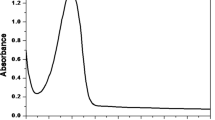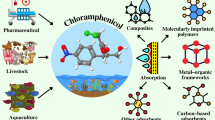Abstract
S-nitrosothiols (RSNOs) have many biological functions including platelet deactivation, immunosupression, neurotransmission, and host defense. Most of the functions are attributed to nitric oxide (NO) release during S-nitrosothiol decomposition. As the simplest biologically occurring S-nitrosothiol, S-nitrosocysteine (CySNO) has been widely used as an NO donor and has also been incorporated into biomedical polymers. Knowledge of the CySNO decomposition rate is important for assessing the impact of CySNO on various bioengineering applications or biological systems. In this work, spectrophotometer measurements of CySNO decomposition in the presence of metal ions showed that the decomposition rate is highly susceptible to the pH. The maximum decomposition occurs near physiological pH (near 7.4) while in the acidic (pH < 6) and alkaline (pH > 9) condition CySNO is very stable. This demonstrates that blood provides an optimized environment for the decomposition of CySNO leading to the release of NO. The CySNO decomposition rate can also be affected by buffers with different purity levels in the presence and absence of metal ion chelators—although all buffers show the same pH phenomenon of maximizing near physiological pH. An equilibrium model of metal ions as a function of pH provides a plausible explanation for the pH dependence on the experimental decomposition rate.




Similar content being viewed by others
Abbreviations
- RSNO:
-
S-nitrosothiol
- NO:
-
nitric oxide
- CySNO:
-
S-nitrosocysteine
- AlbSNO:
-
S-nitrosoalbumin
- k :
-
first-order rate constant
- k obs :
-
observed first-order rate constant
- f B :
-
fraction of metal ion in the form of species B
References
Adam C., Garcia-Rio L., Leis J. R., Ribeiro L. 2005 Nitroso group transfer in S-nitrosocysteine: evidence of a new decomposition pathway for nitrosothiols. J. Org. Chem. 70(16):6353–6361
Al-Sa’Doni H., Ferro A. 2000 S-nitrosothiols: a class of nitric oxide-donor drugs. Clin. Sci. 98(5):507–520
Askew S. C., Barnett J. D., McAninly J., Williams D. L. H. 1995 Catalysis by Cu2+ of nitric oxide release from S-nitrosothiols (RSNO). J. Am. Chem. Soc., Perkin Trans. 2: Phys. Org. Chem. 4:741–745
Beynon, R. J., and J. S. Easterby. Buffer Solutions: The Basics. Oxford: Oxford University Press, 84 pp, 1996
Burg A., Cohen H., Meyerstein D. 2000 The reaction mechanism of nitrosothiols with copper(I). J. Biol. Inorg. Chem. 5(2):213–217
Butler A. R., Williams D. L. H. 1993 The physiological role of nitric oxide. Chem. Soc. Rev. 22(4):233–241
Cooney, D. Biomedical Engineering Principles: An Introduction to Fluid, Heat, and Mass Transport Processes. New York: M. Dekker, 458 pp, 1976
Dicks A. P., Williams D. L. H. 1996 Generation of nitric oxide from S-nitrosothiols using protein-bound Cu2+ sources. Chem. Biol. 3(8):655–659
Duan X., Lewis R. S. 2002 Improved hemocompatibility of cysteine-modified polymers via endogenous nitric oxide. Biomaterials 23(4):1197–1203
Gappa-Fahlenkamp H., Lewis R. S. 2005 Improved hemocompatibility of poly(ethylene terephthalate) modified with various thiol-containing groups. Biomaterials 26(17):3479–3485
Giustarini D., Milzani A., Colombo R., Dalle-Donne I., Rossi R. 2003 Nitric oxide and S-nitrosothiols in human blood. Clin. Chim. Acta 330(1–2):85–98
Hinderling P., Hartmann D. 2005 The pH dependency of the binding of drugs to plasma proteins in man. Ther. Drug Monit. 27(1):71–85
Kelm M. 1999 Nitric oxide metabolism and breakdown. Biochim. Biophys. Acta 1411(2–3):273–289
Kurenny D. E., Moroz L. L., Turner R. W., Sharkey K. A., Barnes S. 1994 Modulation of ion channels in rod photoreceptors by nitric oxide. Neuron 13(2):315–324
Mathews W. R., Kerr S. W. 1993 Biological activity of S-nitrosothiols: the role of nitric oxide. J. Pharmacol. Exp. Ther. 267(3):1529–1537
McAninly J., Williams D. L. H., Askew S. C., Butler A. R., Russell C. 1993 Metal ion catalysis in nitrosothiol (RSNO) decomposition. J. Am. Chem. Soc., Chem. Commun. 23:1758–1759
Meyer D. J., Kramer H., Ozer N., Coles B., Ketterer B. 1994 Kinetics and equilibria of S-nitrosothiol—thiol exchange between glutathione, cysteine, penicillamines and serum albumin. FEBS Lett. 345(2–3):177–180
Murayama T., Nomura Y. 1998 The actions of NO in the central nervous system and in thymocytes. Jpn. J. Pharmacol. 76(2):129–139
Palmer D. A., Benezeth P., Simonson J. M. 2004 The solubility of copper oxides around the water/steam cycle. Power Plant Chem. 6(2):81–88
Pietraforte D., Mallozzi C., Scorza G., Minetti M. 1995 Role of thiols in the targeting of S-nitroso thiols to red blood cells. Biochemistry 34(21):7177–7185
Ramamurthi A. L., Lewis R. S. 2000 Influence of agonist, shear rate, and perfusion time on nitric oxide inhibition of platelet deposition. Ann. Biomed. Eng. 28(2):174–181
Richards C. D., Metcalfe J. C., Smith G. A., Hesketh T. R. 1984 Changes in free-calcium levels and pH in synaptosomes during transmitter release. Biochim. Biophys. Acta Mol. Cell. Res. 803(4):215–220
Richardson G., Benjamin N. 2002 Potential therapeutic uses for S-nitrosothiols. Clin. Sci. 102(1):99–105
Richie J. P. Jr., Abraham P., Leutzinger Y. 1996 Long-term stability of blood glutathione and cysteine in humans. Clin. Chem. 42(7):1100–1105
Scorza G., Pietraforte D., Minetti M. 1996 Role of ascorbate and protein thiols in the release of nitric oxide from S-nitroso-albumin and S-nitroso-glutathione in human plasma. Free Radical Biol. Med. 22(4):633–642
Smith J. N., Dasgupta T. P. 2000 Kinetics and mechanism of the decomposition of S-nitrosoglutathione by—ascorbic acid and copper ions in aqueous solution to produce nitric oxide. Nitric Oxide 4(1):57–66
Stamler J. S., Toone E. J. 2002 The decomposition of thionitrites. Curr. Opin. Chem. Biol. 6(6):779–785
Stuesse D. C., Giraud G. D., Vlessis A. A., Starr A., Trunkey D. D. 2001 Hemodynamic effects of S-nitrosocysteine, an intravenous regional vasodilator. J. Thorac. Cardiovasc. Surg. 122(2):371–377
Swift H. R., Williams D. L. H. 1997 Decomposition of S-nitrosothiols by mercury(II) and silver salts. J. Am. Chem. Soc., Perkin Trans. 2: Phys. Org. Chem. 10:1933–1935
Tullett J. M., Rees D. D., Shuker D. E. G., Gescher A. 2001 Lack of correlation between the observed stability and pharmacological properties of S-nitroso derivatives of glutathione and cysteine-related peptides. Biochem. Pharmacol. 62(9):1239–1247
Vanin A. F., Malenkova I. V., Serezhenkov V. A. 1997 Iron catalyzes both decomposition and synthesis of S-nitrosothiols: optical and electron paramagnetic resonance studies. Nitric Oxide 1(3):191–203
Vanin A. F., Papina A. A., Serezhenkov V. A., Koppenol W. H. 2004 The mechanisms of S-nitrosothiol decomposition catalyzed by iron. Nitric Oxide 10(2):60–73
Williams D. L. H. 1996 S-nitrosothiols and role of metal ions in decomposition to nitric oxide. Methods Enzymol. 268:299–308
Williams D. L. H. 1999 The chemistry of S-nitrosothiols. Acc. Chem. Res. 32(10):869–876
Acknowledgments
This work was supported by a grant from the Oklahoma Center for the Advancement of Science and Technology to R.S.L. (HN6-006).
Author information
Authors and Affiliations
Corresponding author
Rights and permissions
About this article
Cite this article
Gu, J., Lewis, R.S. Effect of pH and Metal Ions on the Decomposition Rate of S-nitrosocysteine. Ann Biomed Eng 35, 1554–1560 (2007). https://doi.org/10.1007/s10439-007-9327-5
Received:
Accepted:
Published:
Issue Date:
DOI: https://doi.org/10.1007/s10439-007-9327-5




